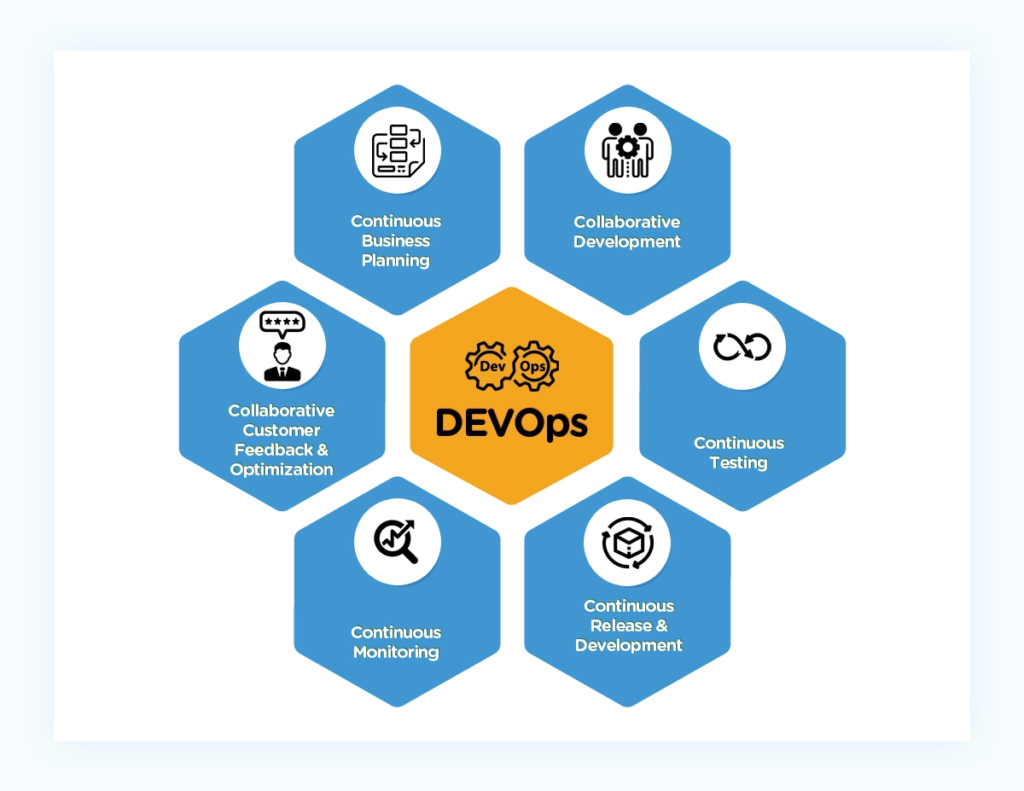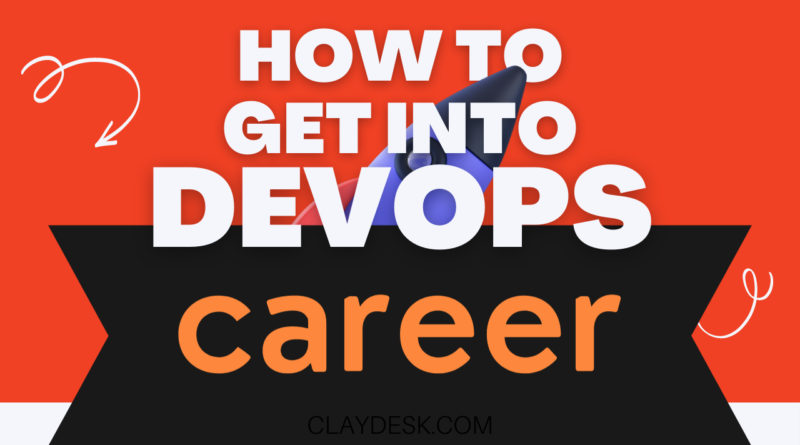How To Get Into DevOps
Introduction – How To Get Into DevOps
The DevOps life cycle is a continuous process of developing, deploying, and managing software applications, services, and infrastructure. Furthermore, it is a set of practices that emphasizes collaboration and communication between development and operations teams to build, test, deploy, and maintain applications more quickly and efficiently.
Basically, the DevOps life cycle can be broken down into several stages:
- Plan: In this stage, the team identifies the objectives of the project and creates a plan to achieve those goals.
- Develop: This stage involves writing the code, testing it, and integrating it with other components.
- Next is Build: In this stage, the code is compiled, built, and packaged into deployable artifacts.
- Test: The software is tested for functionality, performance, security, and other quality attributes.
- Deploy: The software is deployed to production or a staging environment.
- Operate: The software is monitored and managed in the production environment to ensure it is performing as expected.
- Monitor: In this stage, the team collects and analyzes metrics to identify and resolve issues.
- Iterate: Based on the results of monitoring and analysis, the team makes improvements and begins the cycle again.
These stages are not necessarily linear, and different organizations may have different approaches to implementing the DevOps life cycle. However, the key principles of collaboration, automation, and continuous improvement are essential to successful DevOps practices. In addition, let’s explore top 10 DevOps challenges below.
Top 10 DevOps Challenges: How to get into DevOps
Here are ten challenges that can arise when working in DevOps:
- Collaboration: DevOps requires effective collaboration and communication across teams, which can be challenging. Thus, especially in larger organizations where teams may be spread across different locations and time zones.
- Continuous integration and deployment: CI/CD pipelines must be implemented, maintained, and tested regularly to ensure that changes are continuously integrated and deployed with minimal disruption to production environments.
- Automation: DevOps requires the automation of as many processes as possible. Above all, this can be a significant undertaking, especially when integrating multiple tools and technologies.
- Scalability: Applications and infrastructure must be designed to scale efficiently, which can be challenging, especially in complex systems.
- Security: DevOps teams must be vigilant about security, implementing robust security practices to protect systems and data from cyber threats.
- Monitoring: Monitoring and logging systems must be set up and managed to detect and diagnose issues quickly. Hence, this can be challenging when dealing with large volumes of data.
- Infrastructure as Code (IaC): IaC tools must be implemented, maintained, and tested regularly to ensure that infrastructure is deployed consistently. Basically, with minimal disruption to production environments.
- Technical debt: Technical debt can accumulate when short-term solutions are implemented quickly to address pressing issues. As this can cause long-term problems if not addressed regularly.
- Resistance to change: Resistance to change can be a significant challenge. Moreover, in larger organizations where teams may be resistant to new technologies, processes, or cultural changes.
- Continuous learning: DevOps is a fast-paced and constantly evolving field, which requires continuous learning and upskilling to stay relevant and effective. Therefore, keeping up with new tools and technologies can be challenging, but it is essential to maintain a competitive edge in the industry.
How To Get Into DevOps
Getting into DevOps requires a combination of technical skills, knowledge, and hands-on experience. Thus, here are concrete steps with examples to help you get started on your DevOps journey:
- Learn about DevOps Principles and Practices: Familiarize yourself with the core principles and practices of DevOps, such as continuous integration, continuous delivery/deployment, infrastructure as code, and automated testing. Read books like “The Phoenix Project” by Gene Kim, “DevOps Handbook” by Gene Kim, Jez Humble, and others, or take online courses that cover these topics.
- Acquire Knowledge of Relevant Technologies: Gain proficiency in tools commonly used in DevOps environments.
- Examples include:
- Source code management: Git (e.g., learn Git commands, branching strategies).
- Configuration management: Ansible, Puppet, Chef (learn how to write infrastructure code).
- Continuous integration/continuous delivery (CI/CD): Jenkins, Travis CI, GitLab CI/CD (learn how to set up build pipelines, write tests).
- Containerization and orchestration: Docker, Kubernetes (learn how to create Docker containers, deploy and manage Kubernetes clusters).
- Cloud platforms: AWS, Azure, Google Cloud Platform (GCP) (learn how to provision resources, automate deployments).
How To Get Into DevOps Continued
- Gain Hands-On Experience: Practice your skills by working on projects and implementing DevOps practices. Examples of projects you can undertake include:
- Set up a CI/CD pipeline: Use a tool like Jenkins to automate building, testing, and deploying a web application to a development server.
- Infrastructure as code: Use a tool like Ansible or Terraform to define and provision infrastructure resources on a cloud platform.
- Containerization and orchestration: Dockerize a simple application and deploy it to a Kubernetes cluster.
- Collaborate with Others: Engage with the DevOps community and collaborate with professionals in the field. Participate in forums, attend meetups, and contribute to open-source projects. Moreover, sharing your knowledge and learning from others will help you gain insights and grow your network.
- Continuous Learning: DevOps is an ever-evolving field, so staying up to date is crucial. Follow industry blogs, join relevant online communities, and take part in conferences and webinars. Regularly update your skills and explore new tools and technologies.
- Certification: Basically, not mandatory, certifications can validate your knowledge and enhance your credibility. Therefore, consider obtaining certifications such as AWS Certified DevOps Engineer, Certified Kubernetes Administrator (CKA), or Certified Jenkins Engineer.
Thus, the key to success in DevOps is a combination of hands-on experience, continuous learning, and a willingness to adapt to new technologies and practices. Basically, start small, build your skills, and gradually take on more complex projects to grow as a DevOps professional.
Understanding Software Development Life Cycle (SDLC)
SDLC stands for Software Development Life Cycle. Furthermore, it is a process used by software development teams to plan, design, build, test, deploy, and maintain software applications. Hence, the SDLC provides a framework for developing software that ensures that it meets the requirements of stakeholders. Additionally, it is of high quality, and is delivered on time and within budget.
The typical phases of the SDLC include:
- Planning: In this phase, the objectives of the software application are identified. Also a plan is developed to achieve those objectives. This includes identifying requirements, establishing timelines, and determining resource needs.
- Analysis: In this phase, the requirements for the software application are analyzed to determine the feasibility of the project. This includes identifying any constraints, risks, and opportunities.
- Design: In this phase, the software application is designed based on the requirements and analysis. This includes creating a detailed design, defining the architecture, and selecting the appropriate technologies.
- Implementation: In this phase, the software application is developed according to the design. Therefore, this includes writing code, creating databases, and integrating third-party components.
- Testing: In this phase, the software application is tested to ensure that it meets the requirements and is of high quality. This includes unit testing, integration testing, system testing, and acceptance testing.
- Deployment: In this phase, the software application is deployed to the production environment. Hence, this includes installing the software, configuring it for use, and training end-users.
- Maintenance: In this phase, the software application is maintained and updated. This ensures that it continues to meet the needs of stakeholders. Above all, this includes fixing bugs, adding new features, and upgrading components.
Therefore, the SDLC provides a structured approach to software development. Hence, it helps ensure that software applications are of high quality, meet stakeholder needs, and are delivered on time and within budget.
Top 5 DevOps Tools
here are five popular DevOps tools in no particular order:
- Jenkins: An open-source automation server used for building, testing, and deploying software.
- Docker: A containerization platform that enables developers to create, deploy, and run applications in containers.
- Ansible: An open-source IT automation tool used for configuration management, application deployment, and task automation.
- Kubernetes: An open-source container orchestration system used for automating deployment, scaling, and management of containerized applications.
- Git: A version control system used for tracking changes in source code during software development, allowing for collaboration among developers.

AWS Learning Roadmap
Here is a roadmap for learning AWS and getting AWS certified:
Step 1: Understand the basics of Cloud Computing. Before diving into AWS, it’s important to understand the fundamentals of cloud computing. For example its advantages and disadvantages, cloud service models, and deployment models.
Step 2: Choose a Certification Path AWS offers multiple certifications. For instance, Solutions Architect, Developer, SysOps Administrator, DevOps Engineer, and Specialty certifications. Each certification has different prerequisites, so choose the one that aligns with your goals and experience.
Step 3: Learn AWS Fundamentals Start by learning the basics of AWS, including its services, architecture, and pricing model.
Step 4: Deep Dive into AWS Services AWS offers hundreds of services. Thus, it is important to learn about the ones that are relevant to your certification. For example, if you’re pursuing a Solutions Architect certification, you’ll want to know about EC2, S3, RDS, VPC, and CloudFront.
Step 5: Practice on AWS Hands-on experience is essential for mastering AWS. AWS offers free tier accounts that you can use to experiment with the services and build your own projects.
Step 6: Take AWS Training AWS provides training resources. For example, documentation, whitepapers, videos, and online training courses. These will help you learn about its services and prepare for the certification exam.
Step 7: Get AWS Certified When you’re ready. Register for the certification exam and take it at an authorized testing center or online. Once you pass the exam, you’ll receive a certificate that verifies your knowledge of AWS.
Step 8: Stay Up-to-Date with AWS AWS is constantly evolving. Therefore, it’s important to stay current with the latest services and updates. Attend AWS events, read AWS blogs, and join AWS user groups to stay informed.
By following this roadmap, you can learn AWS and earn your certification. This will demonstrate your proficiency in cloud computing and make you a valuable asset to any organization that uses AWS.

Conclusion
Thus, a well-defined DevOps pipeline ensures that each environment has a clearly defined purpose and that the application is deployed and tested in a consistent manner throughout the pipeline.
Want to learn web development? The Web Developer Bootcamp course by ClayDesk can be a great asset for your learning journey.




